An analysis of a case study organisation and recommendations for a marketing strategy
VerifiedAdded on 2023/04/23
|15
|4054
|246
AI Summary
Contribute Materials
Your contribution can guide someone’s learning journey. Share your
documents today.

Running head: AN ANALYSIS OF A CASE STUDY ORGANISATION AND RECOMMENDATIONS FOR
A MARKETING STRATEGY
An analysis of a case study organisation and recommendations for a marketing strategy
Student’s Name
University Name
Author’s Note
A MARKETING STRATEGY
An analysis of a case study organisation and recommendations for a marketing strategy
Student’s Name
University Name
Author’s Note
Secure Best Marks with AI Grader
Need help grading? Try our AI Grader for instant feedback on your assignments.
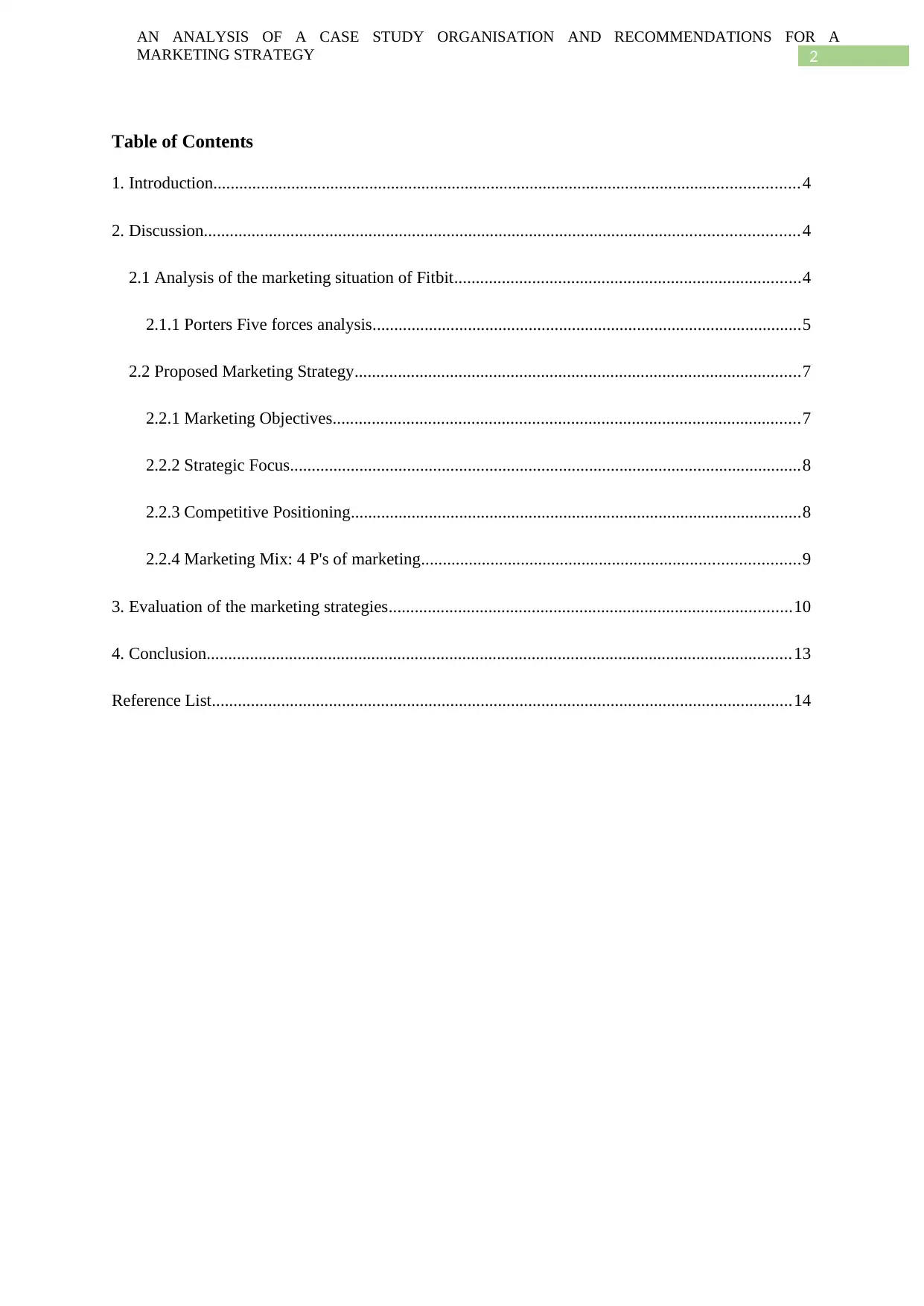
2
AN ANALYSIS OF A CASE STUDY ORGANISATION AND RECOMMENDATIONS FOR A
MARKETING STRATEGY
Table of Contents
1. Introduction.......................................................................................................................................4
2. Discussion.........................................................................................................................................4
2.1 Analysis of the marketing situation of Fitbit................................................................................4
2.1.1 Porters Five forces analysis...................................................................................................5
2.2 Proposed Marketing Strategy.......................................................................................................7
2.2.1 Marketing Objectives............................................................................................................7
2.2.2 Strategic Focus......................................................................................................................8
2.2.3 Competitive Positioning........................................................................................................8
2.2.4 Marketing Mix: 4 P's of marketing.......................................................................................9
3. Evaluation of the marketing strategies.............................................................................................10
4. Conclusion.......................................................................................................................................13
Reference List......................................................................................................................................14
AN ANALYSIS OF A CASE STUDY ORGANISATION AND RECOMMENDATIONS FOR A
MARKETING STRATEGY
Table of Contents
1. Introduction.......................................................................................................................................4
2. Discussion.........................................................................................................................................4
2.1 Analysis of the marketing situation of Fitbit................................................................................4
2.1.1 Porters Five forces analysis...................................................................................................5
2.2 Proposed Marketing Strategy.......................................................................................................7
2.2.1 Marketing Objectives............................................................................................................7
2.2.2 Strategic Focus......................................................................................................................8
2.2.3 Competitive Positioning........................................................................................................8
2.2.4 Marketing Mix: 4 P's of marketing.......................................................................................9
3. Evaluation of the marketing strategies.............................................................................................10
4. Conclusion.......................................................................................................................................13
Reference List......................................................................................................................................14
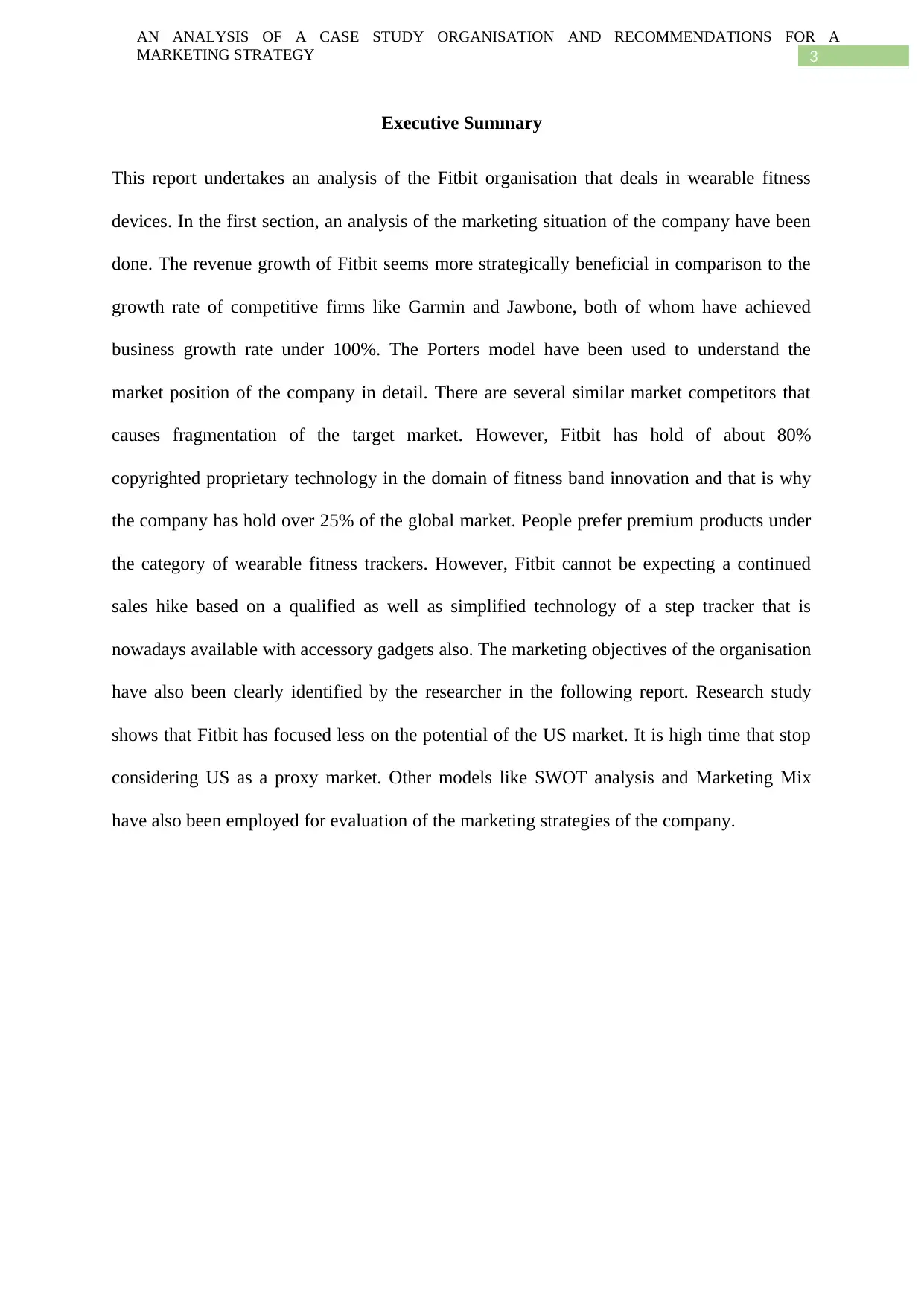
3
AN ANALYSIS OF A CASE STUDY ORGANISATION AND RECOMMENDATIONS FOR A
MARKETING STRATEGY
Executive Summary
This report undertakes an analysis of the Fitbit organisation that deals in wearable fitness
devices. In the first section, an analysis of the marketing situation of the company have been
done. The revenue growth of Fitbit seems more strategically beneficial in comparison to the
growth rate of competitive firms like Garmin and Jawbone, both of whom have achieved
business growth rate under 100%. The Porters model have been used to understand the
market position of the company in detail. There are several similar market competitors that
causes fragmentation of the target market. However, Fitbit has hold of about 80%
copyrighted proprietary technology in the domain of fitness band innovation and that is why
the company has hold over 25% of the global market. People prefer premium products under
the category of wearable fitness trackers. However, Fitbit cannot be expecting a continued
sales hike based on a qualified as well as simplified technology of a step tracker that is
nowadays available with accessory gadgets also. The marketing objectives of the organisation
have also been clearly identified by the researcher in the following report. Research study
shows that Fitbit has focused less on the potential of the US market. It is high time that stop
considering US as a proxy market. Other models like SWOT analysis and Marketing Mix
have also been employed for evaluation of the marketing strategies of the company.
AN ANALYSIS OF A CASE STUDY ORGANISATION AND RECOMMENDATIONS FOR A
MARKETING STRATEGY
Executive Summary
This report undertakes an analysis of the Fitbit organisation that deals in wearable fitness
devices. In the first section, an analysis of the marketing situation of the company have been
done. The revenue growth of Fitbit seems more strategically beneficial in comparison to the
growth rate of competitive firms like Garmin and Jawbone, both of whom have achieved
business growth rate under 100%. The Porters model have been used to understand the
market position of the company in detail. There are several similar market competitors that
causes fragmentation of the target market. However, Fitbit has hold of about 80%
copyrighted proprietary technology in the domain of fitness band innovation and that is why
the company has hold over 25% of the global market. People prefer premium products under
the category of wearable fitness trackers. However, Fitbit cannot be expecting a continued
sales hike based on a qualified as well as simplified technology of a step tracker that is
nowadays available with accessory gadgets also. The marketing objectives of the organisation
have also been clearly identified by the researcher in the following report. Research study
shows that Fitbit has focused less on the potential of the US market. It is high time that stop
considering US as a proxy market. Other models like SWOT analysis and Marketing Mix
have also been employed for evaluation of the marketing strategies of the company.
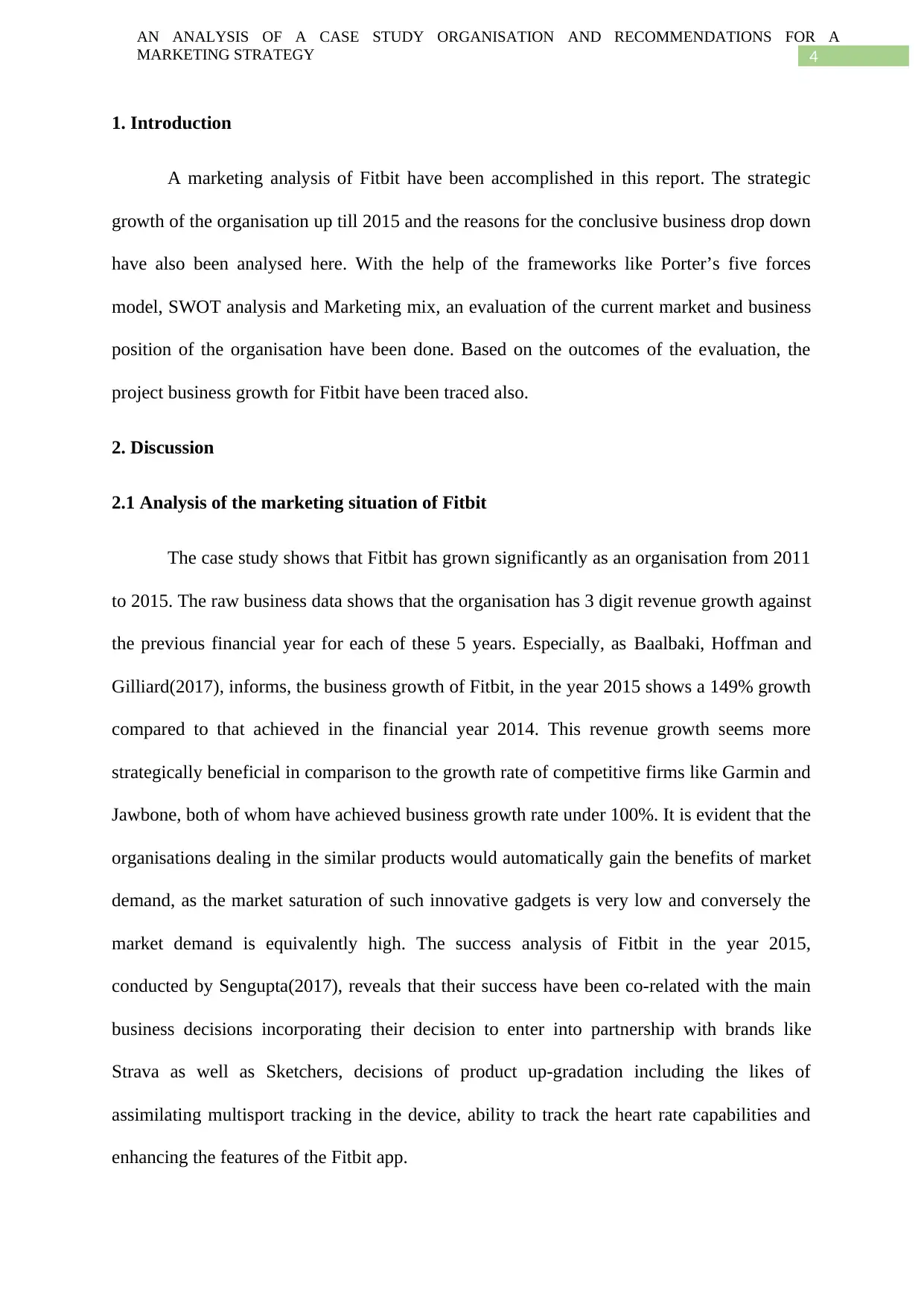
4
AN ANALYSIS OF A CASE STUDY ORGANISATION AND RECOMMENDATIONS FOR A
MARKETING STRATEGY
1. Introduction
A marketing analysis of Fitbit have been accomplished in this report. The strategic
growth of the organisation up till 2015 and the reasons for the conclusive business drop down
have also been analysed here. With the help of the frameworks like Porter’s five forces
model, SWOT analysis and Marketing mix, an evaluation of the current market and business
position of the organisation have been done. Based on the outcomes of the evaluation, the
project business growth for Fitbit have been traced also.
2. Discussion
2.1 Analysis of the marketing situation of Fitbit
The case study shows that Fitbit has grown significantly as an organisation from 2011
to 2015. The raw business data shows that the organisation has 3 digit revenue growth against
the previous financial year for each of these 5 years. Especially, as Baalbaki, Hoffman and
Gilliard(2017), informs, the business growth of Fitbit, in the year 2015 shows a 149% growth
compared to that achieved in the financial year 2014. This revenue growth seems more
strategically beneficial in comparison to the growth rate of competitive firms like Garmin and
Jawbone, both of whom have achieved business growth rate under 100%. It is evident that the
organisations dealing in the similar products would automatically gain the benefits of market
demand, as the market saturation of such innovative gadgets is very low and conversely the
market demand is equivalently high. The success analysis of Fitbit in the year 2015,
conducted by Sengupta(2017), reveals that their success have been co-related with the main
business decisions incorporating their decision to enter into partnership with brands like
Strava as well as Sketchers, decisions of product up-gradation including the likes of
assimilating multisport tracking in the device, ability to track the heart rate capabilities and
enhancing the features of the Fitbit app.
AN ANALYSIS OF A CASE STUDY ORGANISATION AND RECOMMENDATIONS FOR A
MARKETING STRATEGY
1. Introduction
A marketing analysis of Fitbit have been accomplished in this report. The strategic
growth of the organisation up till 2015 and the reasons for the conclusive business drop down
have also been analysed here. With the help of the frameworks like Porter’s five forces
model, SWOT analysis and Marketing mix, an evaluation of the current market and business
position of the organisation have been done. Based on the outcomes of the evaluation, the
project business growth for Fitbit have been traced also.
2. Discussion
2.1 Analysis of the marketing situation of Fitbit
The case study shows that Fitbit has grown significantly as an organisation from 2011
to 2015. The raw business data shows that the organisation has 3 digit revenue growth against
the previous financial year for each of these 5 years. Especially, as Baalbaki, Hoffman and
Gilliard(2017), informs, the business growth of Fitbit, in the year 2015 shows a 149% growth
compared to that achieved in the financial year 2014. This revenue growth seems more
strategically beneficial in comparison to the growth rate of competitive firms like Garmin and
Jawbone, both of whom have achieved business growth rate under 100%. It is evident that the
organisations dealing in the similar products would automatically gain the benefits of market
demand, as the market saturation of such innovative gadgets is very low and conversely the
market demand is equivalently high. The success analysis of Fitbit in the year 2015,
conducted by Sengupta(2017), reveals that their success have been co-related with the main
business decisions incorporating their decision to enter into partnership with brands like
Strava as well as Sketchers, decisions of product up-gradation including the likes of
assimilating multisport tracking in the device, ability to track the heart rate capabilities and
enhancing the features of the Fitbit app.
Secure Best Marks with AI Grader
Need help grading? Try our AI Grader for instant feedback on your assignments.
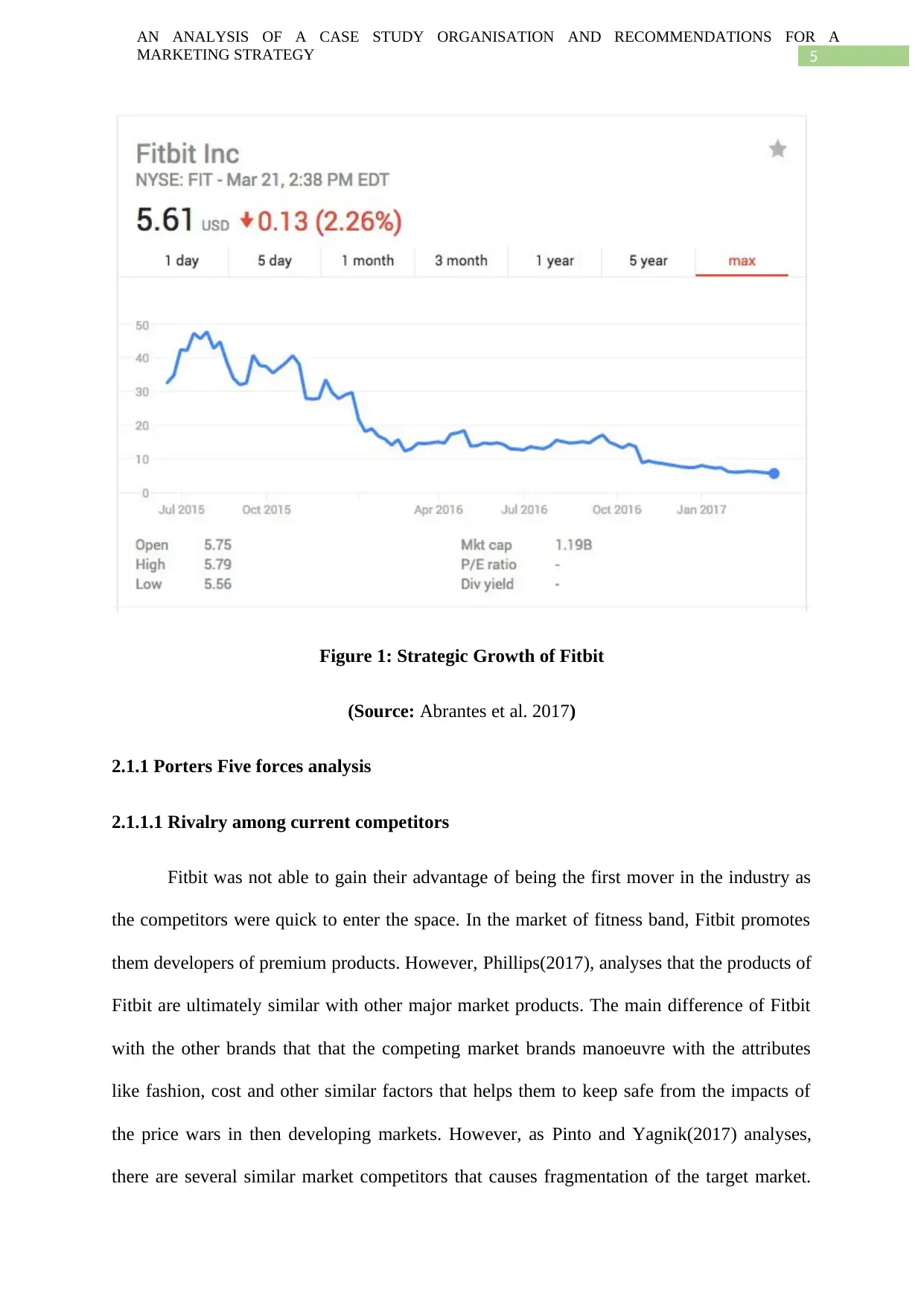
5
AN ANALYSIS OF A CASE STUDY ORGANISATION AND RECOMMENDATIONS FOR A
MARKETING STRATEGY
Figure 1: Strategic Growth of Fitbit
(Source: Abrantes et al. 2017)
2.1.1 Porters Five forces analysis
2.1.1.1 Rivalry among current competitors
Fitbit was not able to gain their advantage of being the first mover in the industry as
the competitors were quick to enter the space. In the market of fitness band, Fitbit promotes
them developers of premium products. However, Phillips(2017), analyses that the products of
Fitbit are ultimately similar with other major market products. The main difference of Fitbit
with the other brands that that the competing market brands manoeuvre with the attributes
like fashion, cost and other similar factors that helps them to keep safe from the impacts of
the price wars in then developing markets. However, as Pinto and Yagnik(2017) analyses,
there are several similar market competitors that causes fragmentation of the target market.
AN ANALYSIS OF A CASE STUDY ORGANISATION AND RECOMMENDATIONS FOR A
MARKETING STRATEGY
Figure 1: Strategic Growth of Fitbit
(Source: Abrantes et al. 2017)
2.1.1 Porters Five forces analysis
2.1.1.1 Rivalry among current competitors
Fitbit was not able to gain their advantage of being the first mover in the industry as
the competitors were quick to enter the space. In the market of fitness band, Fitbit promotes
them developers of premium products. However, Phillips(2017), analyses that the products of
Fitbit are ultimately similar with other major market products. The main difference of Fitbit
with the other brands that that the competing market brands manoeuvre with the attributes
like fashion, cost and other similar factors that helps them to keep safe from the impacts of
the price wars in then developing markets. However, as Pinto and Yagnik(2017) analyses,
there are several similar market competitors that causes fragmentation of the target market.
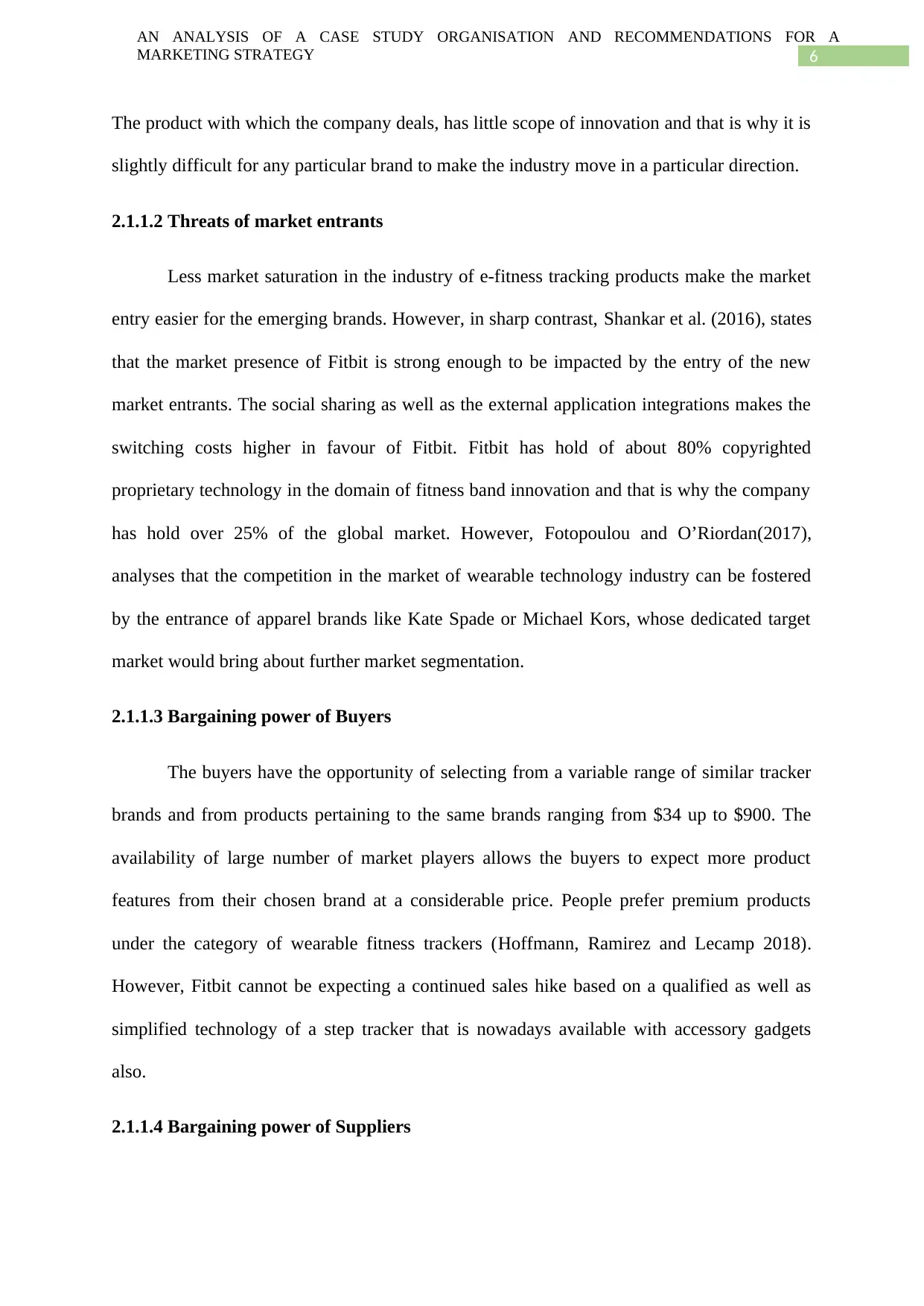
6
AN ANALYSIS OF A CASE STUDY ORGANISATION AND RECOMMENDATIONS FOR A
MARKETING STRATEGY
The product with which the company deals, has little scope of innovation and that is why it is
slightly difficult for any particular brand to make the industry move in a particular direction.
2.1.1.2 Threats of market entrants
Less market saturation in the industry of e-fitness tracking products make the market
entry easier for the emerging brands. However, in sharp contrast, Shankar et al. (2016), states
that the market presence of Fitbit is strong enough to be impacted by the entry of the new
market entrants. The social sharing as well as the external application integrations makes the
switching costs higher in favour of Fitbit. Fitbit has hold of about 80% copyrighted
proprietary technology in the domain of fitness band innovation and that is why the company
has hold over 25% of the global market. However, Fotopoulou and O’Riordan(2017),
analyses that the competition in the market of wearable technology industry can be fostered
by the entrance of apparel brands like Kate Spade or Michael Kors, whose dedicated target
market would bring about further market segmentation.
2.1.1.3 Bargaining power of Buyers
The buyers have the opportunity of selecting from a variable range of similar tracker
brands and from products pertaining to the same brands ranging from $34 up to $900. The
availability of large number of market players allows the buyers to expect more product
features from their chosen brand at a considerable price. People prefer premium products
under the category of wearable fitness trackers (Hoffmann, Ramirez and Lecamp 2018).
However, Fitbit cannot be expecting a continued sales hike based on a qualified as well as
simplified technology of a step tracker that is nowadays available with accessory gadgets
also.
2.1.1.4 Bargaining power of Suppliers
AN ANALYSIS OF A CASE STUDY ORGANISATION AND RECOMMENDATIONS FOR A
MARKETING STRATEGY
The product with which the company deals, has little scope of innovation and that is why it is
slightly difficult for any particular brand to make the industry move in a particular direction.
2.1.1.2 Threats of market entrants
Less market saturation in the industry of e-fitness tracking products make the market
entry easier for the emerging brands. However, in sharp contrast, Shankar et al. (2016), states
that the market presence of Fitbit is strong enough to be impacted by the entry of the new
market entrants. The social sharing as well as the external application integrations makes the
switching costs higher in favour of Fitbit. Fitbit has hold of about 80% copyrighted
proprietary technology in the domain of fitness band innovation and that is why the company
has hold over 25% of the global market. However, Fotopoulou and O’Riordan(2017),
analyses that the competition in the market of wearable technology industry can be fostered
by the entrance of apparel brands like Kate Spade or Michael Kors, whose dedicated target
market would bring about further market segmentation.
2.1.1.3 Bargaining power of Buyers
The buyers have the opportunity of selecting from a variable range of similar tracker
brands and from products pertaining to the same brands ranging from $34 up to $900. The
availability of large number of market players allows the buyers to expect more product
features from their chosen brand at a considerable price. People prefer premium products
under the category of wearable fitness trackers (Hoffmann, Ramirez and Lecamp 2018).
However, Fitbit cannot be expecting a continued sales hike based on a qualified as well as
simplified technology of a step tracker that is nowadays available with accessory gadgets
also.
2.1.1.4 Bargaining power of Suppliers
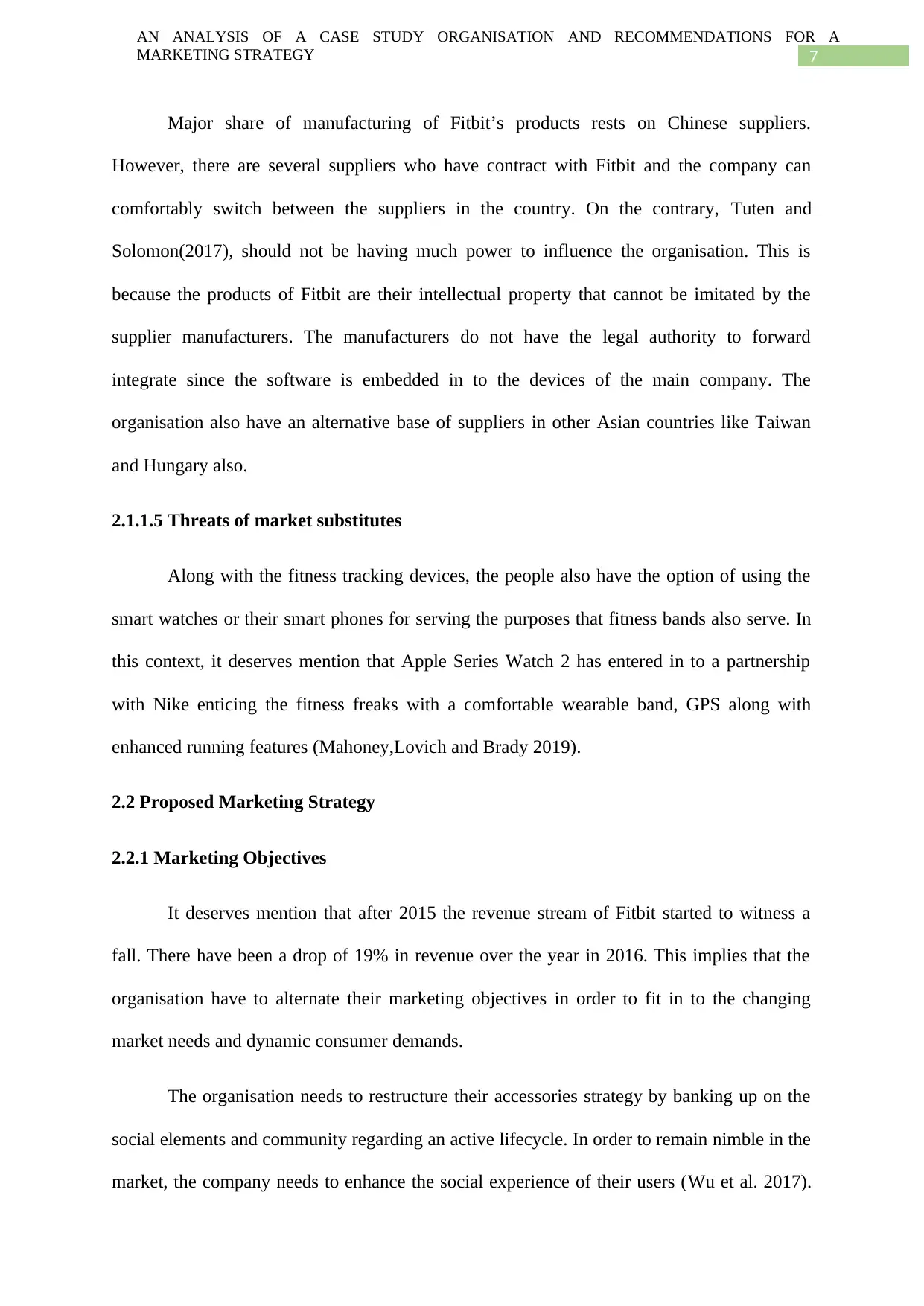
7
AN ANALYSIS OF A CASE STUDY ORGANISATION AND RECOMMENDATIONS FOR A
MARKETING STRATEGY
Major share of manufacturing of Fitbit’s products rests on Chinese suppliers.
However, there are several suppliers who have contract with Fitbit and the company can
comfortably switch between the suppliers in the country. On the contrary, Tuten and
Solomon(2017), should not be having much power to influence the organisation. This is
because the products of Fitbit are their intellectual property that cannot be imitated by the
supplier manufacturers. The manufacturers do not have the legal authority to forward
integrate since the software is embedded in to the devices of the main company. The
organisation also have an alternative base of suppliers in other Asian countries like Taiwan
and Hungary also.
2.1.1.5 Threats of market substitutes
Along with the fitness tracking devices, the people also have the option of using the
smart watches or their smart phones for serving the purposes that fitness bands also serve. In
this context, it deserves mention that Apple Series Watch 2 has entered in to a partnership
with Nike enticing the fitness freaks with a comfortable wearable band, GPS along with
enhanced running features (Mahoney,Lovich and Brady 2019).
2.2 Proposed Marketing Strategy
2.2.1 Marketing Objectives
It deserves mention that after 2015 the revenue stream of Fitbit started to witness a
fall. There have been a drop of 19% in revenue over the year in 2016. This implies that the
organisation have to alternate their marketing objectives in order to fit in to the changing
market needs and dynamic consumer demands.
The organisation needs to restructure their accessories strategy by banking up on the
social elements and community regarding an active lifecycle. In order to remain nimble in the
market, the company needs to enhance the social experience of their users (Wu et al. 2017).
AN ANALYSIS OF A CASE STUDY ORGANISATION AND RECOMMENDATIONS FOR A
MARKETING STRATEGY
Major share of manufacturing of Fitbit’s products rests on Chinese suppliers.
However, there are several suppliers who have contract with Fitbit and the company can
comfortably switch between the suppliers in the country. On the contrary, Tuten and
Solomon(2017), should not be having much power to influence the organisation. This is
because the products of Fitbit are their intellectual property that cannot be imitated by the
supplier manufacturers. The manufacturers do not have the legal authority to forward
integrate since the software is embedded in to the devices of the main company. The
organisation also have an alternative base of suppliers in other Asian countries like Taiwan
and Hungary also.
2.1.1.5 Threats of market substitutes
Along with the fitness tracking devices, the people also have the option of using the
smart watches or their smart phones for serving the purposes that fitness bands also serve. In
this context, it deserves mention that Apple Series Watch 2 has entered in to a partnership
with Nike enticing the fitness freaks with a comfortable wearable band, GPS along with
enhanced running features (Mahoney,Lovich and Brady 2019).
2.2 Proposed Marketing Strategy
2.2.1 Marketing Objectives
It deserves mention that after 2015 the revenue stream of Fitbit started to witness a
fall. There have been a drop of 19% in revenue over the year in 2016. This implies that the
organisation have to alternate their marketing objectives in order to fit in to the changing
market needs and dynamic consumer demands.
The organisation needs to restructure their accessories strategy by banking up on the
social elements and community regarding an active lifecycle. In order to remain nimble in the
market, the company needs to enhance the social experience of their users (Wu et al. 2017).
Paraphrase This Document
Need a fresh take? Get an instant paraphrase of this document with our AI Paraphraser
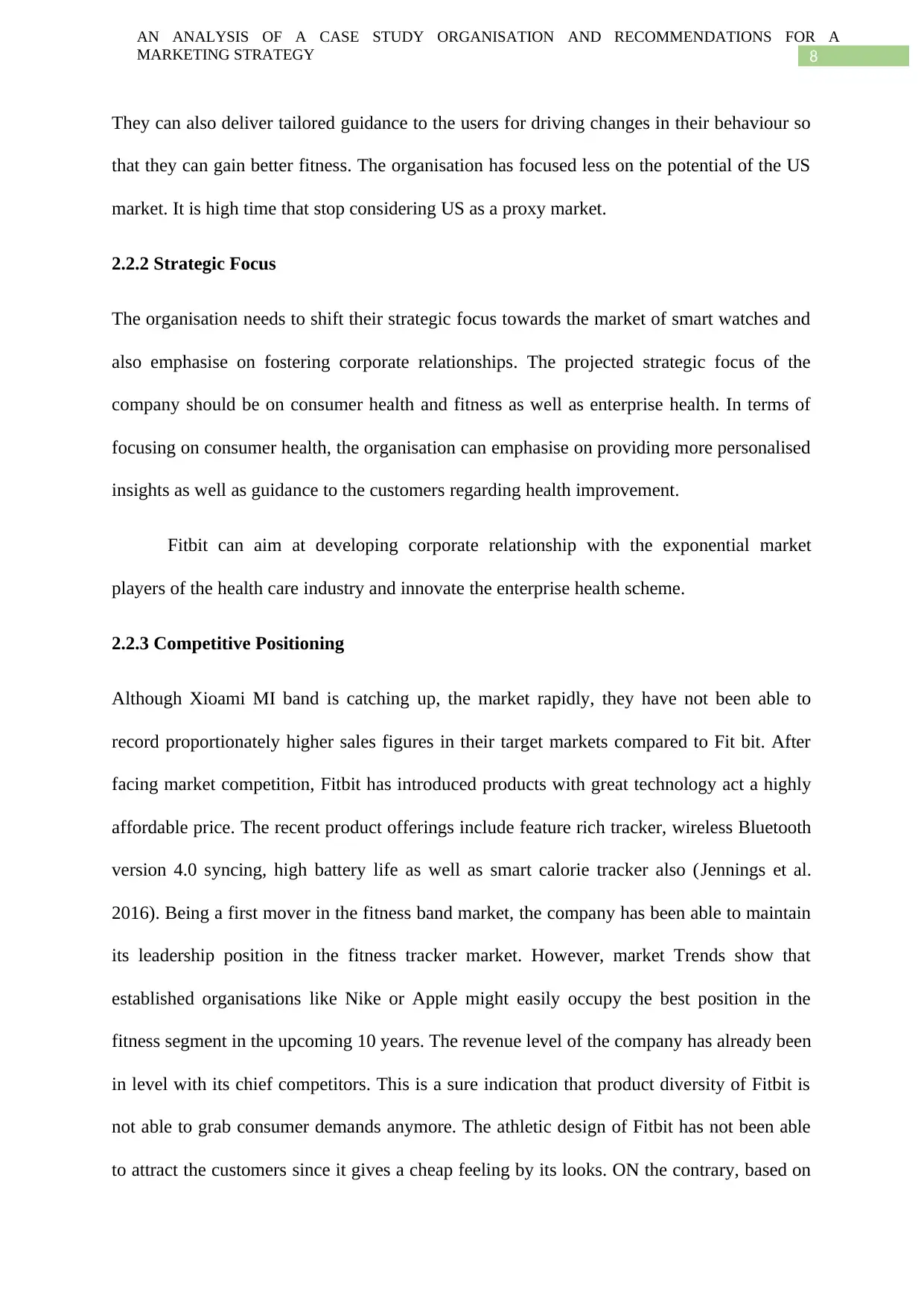
8
AN ANALYSIS OF A CASE STUDY ORGANISATION AND RECOMMENDATIONS FOR A
MARKETING STRATEGY
They can also deliver tailored guidance to the users for driving changes in their behaviour so
that they can gain better fitness. The organisation has focused less on the potential of the US
market. It is high time that stop considering US as a proxy market.
2.2.2 Strategic Focus
The organisation needs to shift their strategic focus towards the market of smart watches and
also emphasise on fostering corporate relationships. The projected strategic focus of the
company should be on consumer health and fitness as well as enterprise health. In terms of
focusing on consumer health, the organisation can emphasise on providing more personalised
insights as well as guidance to the customers regarding health improvement.
Fitbit can aim at developing corporate relationship with the exponential market
players of the health care industry and innovate the enterprise health scheme.
2.2.3 Competitive Positioning
Although Xioami MI band is catching up, the market rapidly, they have not been able to
record proportionately higher sales figures in their target markets compared to Fit bit. After
facing market competition, Fitbit has introduced products with great technology act a highly
affordable price. The recent product offerings include feature rich tracker, wireless Bluetooth
version 4.0 syncing, high battery life as well as smart calorie tracker also (Jennings et al.
2016). Being a first mover in the fitness band market, the company has been able to maintain
its leadership position in the fitness tracker market. However, market Trends show that
established organisations like Nike or Apple might easily occupy the best position in the
fitness segment in the upcoming 10 years. The revenue level of the company has already been
in level with its chief competitors. This is a sure indication that product diversity of Fitbit is
not able to grab consumer demands anymore. The athletic design of Fitbit has not been able
to attract the customers since it gives a cheap feeling by its looks. ON the contrary, based on
AN ANALYSIS OF A CASE STUDY ORGANISATION AND RECOMMENDATIONS FOR A
MARKETING STRATEGY
They can also deliver tailored guidance to the users for driving changes in their behaviour so
that they can gain better fitness. The organisation has focused less on the potential of the US
market. It is high time that stop considering US as a proxy market.
2.2.2 Strategic Focus
The organisation needs to shift their strategic focus towards the market of smart watches and
also emphasise on fostering corporate relationships. The projected strategic focus of the
company should be on consumer health and fitness as well as enterprise health. In terms of
focusing on consumer health, the organisation can emphasise on providing more personalised
insights as well as guidance to the customers regarding health improvement.
Fitbit can aim at developing corporate relationship with the exponential market
players of the health care industry and innovate the enterprise health scheme.
2.2.3 Competitive Positioning
Although Xioami MI band is catching up, the market rapidly, they have not been able to
record proportionately higher sales figures in their target markets compared to Fit bit. After
facing market competition, Fitbit has introduced products with great technology act a highly
affordable price. The recent product offerings include feature rich tracker, wireless Bluetooth
version 4.0 syncing, high battery life as well as smart calorie tracker also (Jennings et al.
2016). Being a first mover in the fitness band market, the company has been able to maintain
its leadership position in the fitness tracker market. However, market Trends show that
established organisations like Nike or Apple might easily occupy the best position in the
fitness segment in the upcoming 10 years. The revenue level of the company has already been
in level with its chief competitors. This is a sure indication that product diversity of Fitbit is
not able to grab consumer demands anymore. The athletic design of Fitbit has not been able
to attract the customers since it gives a cheap feeling by its looks. ON the contrary, based on
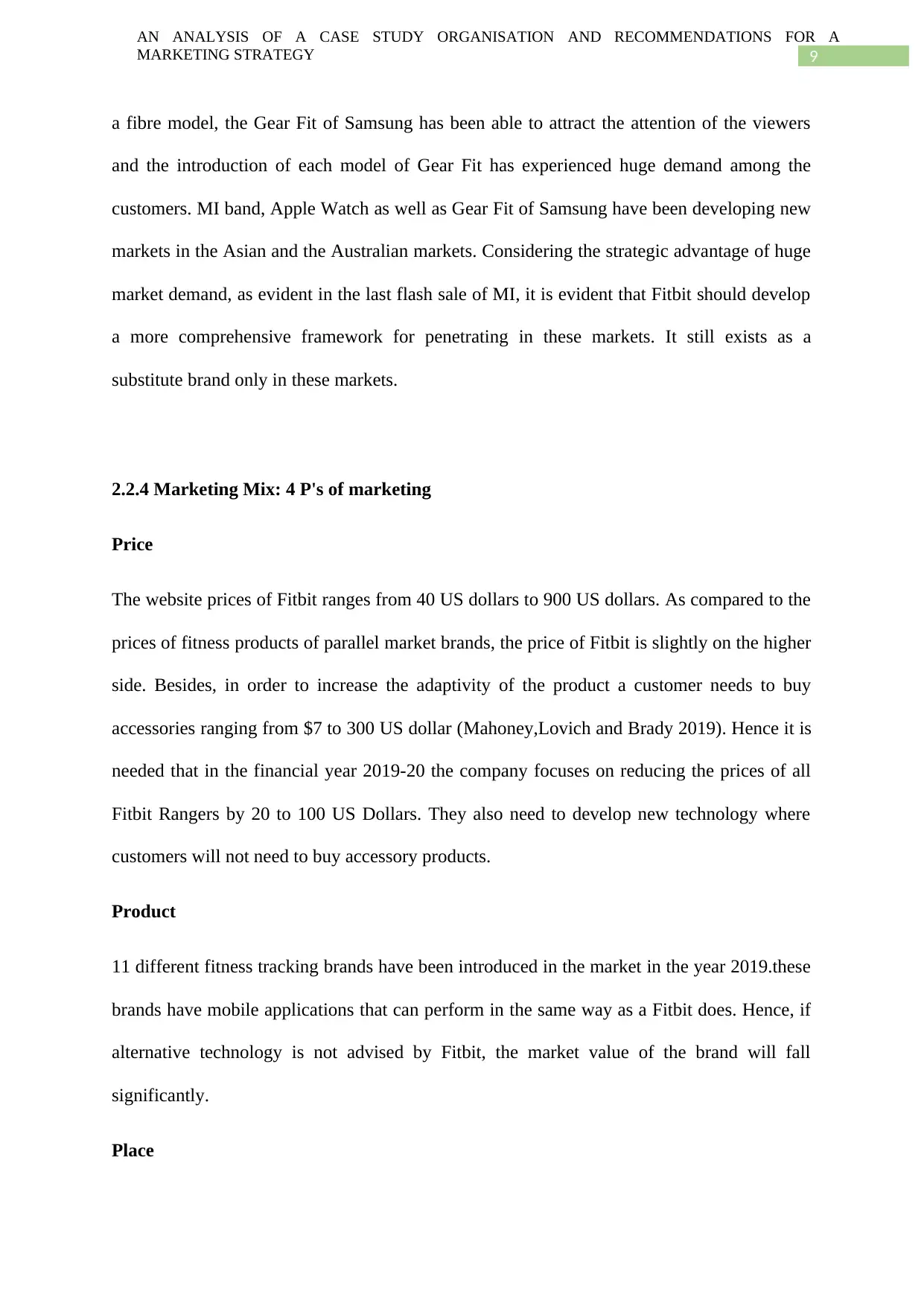
9
AN ANALYSIS OF A CASE STUDY ORGANISATION AND RECOMMENDATIONS FOR A
MARKETING STRATEGY
a fibre model, the Gear Fit of Samsung has been able to attract the attention of the viewers
and the introduction of each model of Gear Fit has experienced huge demand among the
customers. MI band, Apple Watch as well as Gear Fit of Samsung have been developing new
markets in the Asian and the Australian markets. Considering the strategic advantage of huge
market demand, as evident in the last flash sale of MI, it is evident that Fitbit should develop
a more comprehensive framework for penetrating in these markets. It still exists as a
substitute brand only in these markets.
2.2.4 Marketing Mix: 4 P's of marketing
Price
The website prices of Fitbit ranges from 40 US dollars to 900 US dollars. As compared to the
prices of fitness products of parallel market brands, the price of Fitbit is slightly on the higher
side. Besides, in order to increase the adaptivity of the product a customer needs to buy
accessories ranging from $7 to 300 US dollar (Mahoney,Lovich and Brady 2019). Hence it is
needed that in the financial year 2019-20 the company focuses on reducing the prices of all
Fitbit Rangers by 20 to 100 US Dollars. They also need to develop new technology where
customers will not need to buy accessory products.
Product
11 different fitness tracking brands have been introduced in the market in the year 2019.these
brands have mobile applications that can perform in the same way as a Fitbit does. Hence, if
alternative technology is not advised by Fitbit, the market value of the brand will fall
significantly.
Place
AN ANALYSIS OF A CASE STUDY ORGANISATION AND RECOMMENDATIONS FOR A
MARKETING STRATEGY
a fibre model, the Gear Fit of Samsung has been able to attract the attention of the viewers
and the introduction of each model of Gear Fit has experienced huge demand among the
customers. MI band, Apple Watch as well as Gear Fit of Samsung have been developing new
markets in the Asian and the Australian markets. Considering the strategic advantage of huge
market demand, as evident in the last flash sale of MI, it is evident that Fitbit should develop
a more comprehensive framework for penetrating in these markets. It still exists as a
substitute brand only in these markets.
2.2.4 Marketing Mix: 4 P's of marketing
Price
The website prices of Fitbit ranges from 40 US dollars to 900 US dollars. As compared to the
prices of fitness products of parallel market brands, the price of Fitbit is slightly on the higher
side. Besides, in order to increase the adaptivity of the product a customer needs to buy
accessories ranging from $7 to 300 US dollar (Mahoney,Lovich and Brady 2019). Hence it is
needed that in the financial year 2019-20 the company focuses on reducing the prices of all
Fitbit Rangers by 20 to 100 US Dollars. They also need to develop new technology where
customers will not need to buy accessory products.
Product
11 different fitness tracking brands have been introduced in the market in the year 2019.these
brands have mobile applications that can perform in the same way as a Fitbit does. Hence, if
alternative technology is not advised by Fitbit, the market value of the brand will fall
significantly.
Place
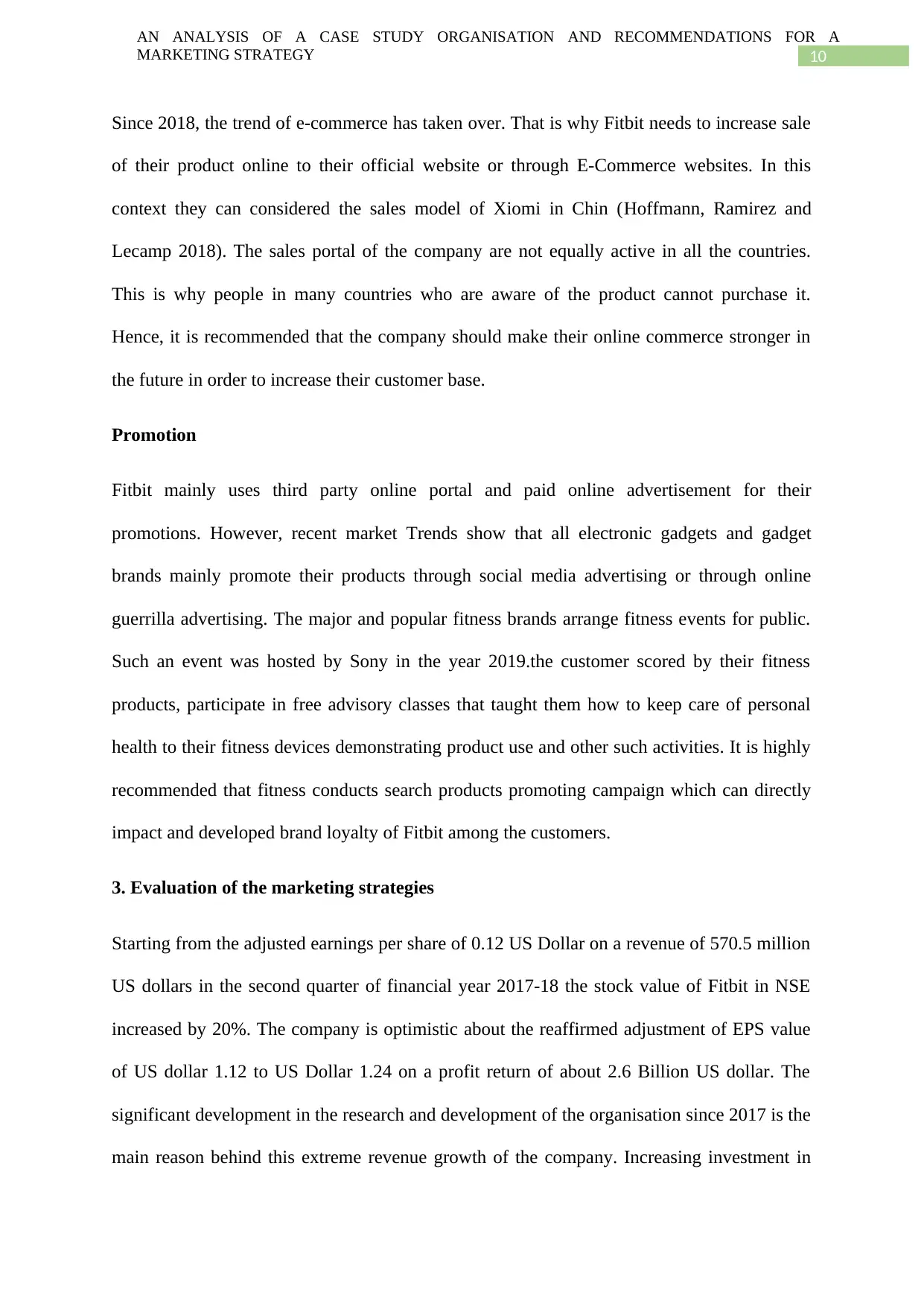
10
AN ANALYSIS OF A CASE STUDY ORGANISATION AND RECOMMENDATIONS FOR A
MARKETING STRATEGY
Since 2018, the trend of e-commerce has taken over. That is why Fitbit needs to increase sale
of their product online to their official website or through E-Commerce websites. In this
context they can considered the sales model of Xiomi in Chin (Hoffmann, Ramirez and
Lecamp 2018). The sales portal of the company are not equally active in all the countries.
This is why people in many countries who are aware of the product cannot purchase it.
Hence, it is recommended that the company should make their online commerce stronger in
the future in order to increase their customer base.
Promotion
Fitbit mainly uses third party online portal and paid online advertisement for their
promotions. However, recent market Trends show that all electronic gadgets and gadget
brands mainly promote their products through social media advertising or through online
guerrilla advertising. The major and popular fitness brands arrange fitness events for public.
Such an event was hosted by Sony in the year 2019.the customer scored by their fitness
products, participate in free advisory classes that taught them how to keep care of personal
health to their fitness devices demonstrating product use and other such activities. It is highly
recommended that fitness conducts search products promoting campaign which can directly
impact and developed brand loyalty of Fitbit among the customers.
3. Evaluation of the marketing strategies
Starting from the adjusted earnings per share of 0.12 US Dollar on a revenue of 570.5 million
US dollars in the second quarter of financial year 2017-18 the stock value of Fitbit in NSE
increased by 20%. The company is optimistic about the reaffirmed adjustment of EPS value
of US dollar 1.12 to US Dollar 1.24 on a profit return of about 2.6 Billion US dollar. The
significant development in the research and development of the organisation since 2017 is the
main reason behind this extreme revenue growth of the company. Increasing investment in
AN ANALYSIS OF A CASE STUDY ORGANISATION AND RECOMMENDATIONS FOR A
MARKETING STRATEGY
Since 2018, the trend of e-commerce has taken over. That is why Fitbit needs to increase sale
of their product online to their official website or through E-Commerce websites. In this
context they can considered the sales model of Xiomi in Chin (Hoffmann, Ramirez and
Lecamp 2018). The sales portal of the company are not equally active in all the countries.
This is why people in many countries who are aware of the product cannot purchase it.
Hence, it is recommended that the company should make their online commerce stronger in
the future in order to increase their customer base.
Promotion
Fitbit mainly uses third party online portal and paid online advertisement for their
promotions. However, recent market Trends show that all electronic gadgets and gadget
brands mainly promote their products through social media advertising or through online
guerrilla advertising. The major and popular fitness brands arrange fitness events for public.
Such an event was hosted by Sony in the year 2019.the customer scored by their fitness
products, participate in free advisory classes that taught them how to keep care of personal
health to their fitness devices demonstrating product use and other such activities. It is highly
recommended that fitness conducts search products promoting campaign which can directly
impact and developed brand loyalty of Fitbit among the customers.
3. Evaluation of the marketing strategies
Starting from the adjusted earnings per share of 0.12 US Dollar on a revenue of 570.5 million
US dollars in the second quarter of financial year 2017-18 the stock value of Fitbit in NSE
increased by 20%. The company is optimistic about the reaffirmed adjustment of EPS value
of US dollar 1.12 to US Dollar 1.24 on a profit return of about 2.6 Billion US dollar. The
significant development in the research and development of the organisation since 2017 is the
main reason behind this extreme revenue growth of the company. Increasing investment in
Secure Best Marks with AI Grader
Need help grading? Try our AI Grader for instant feedback on your assignments.
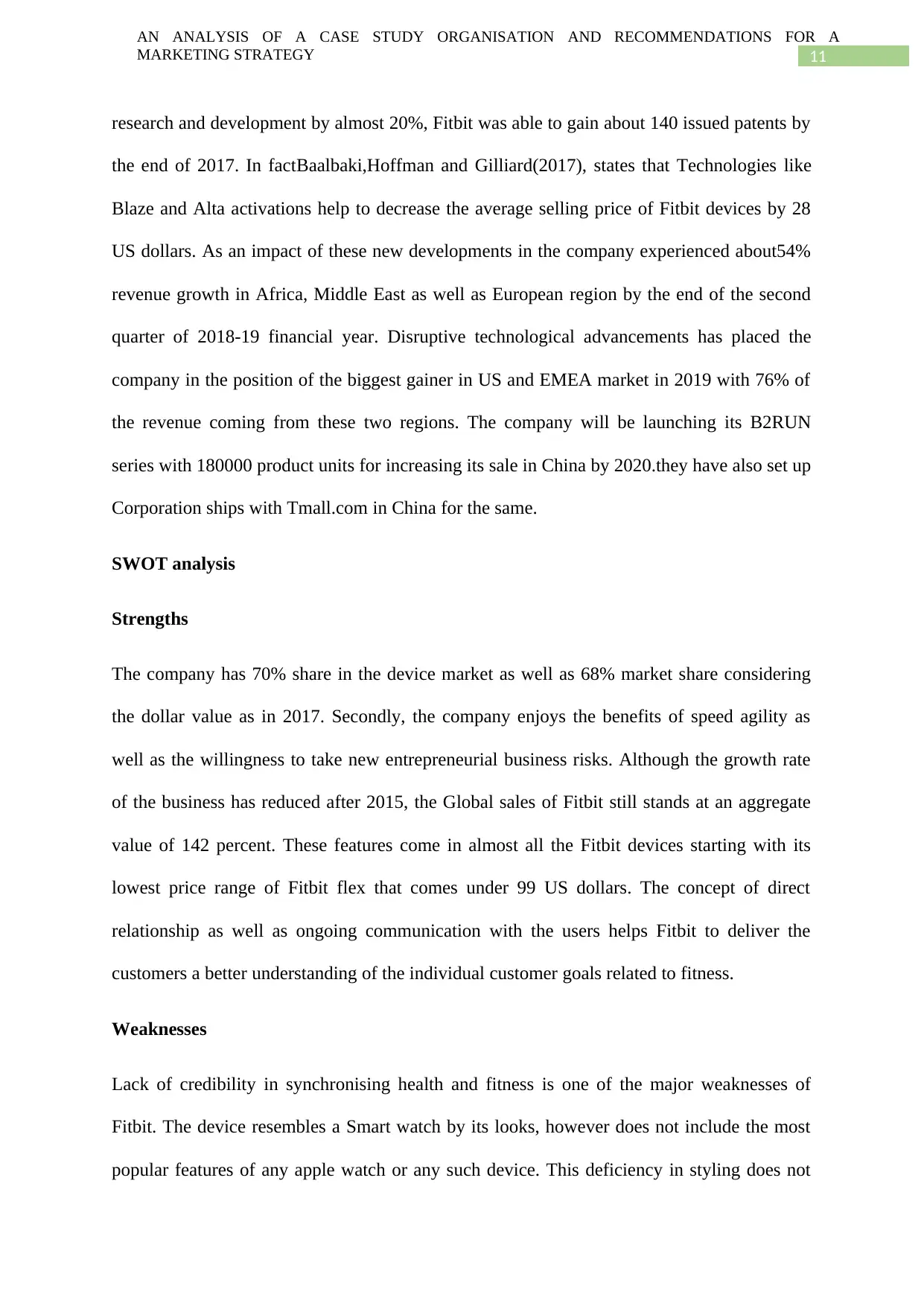
11
AN ANALYSIS OF A CASE STUDY ORGANISATION AND RECOMMENDATIONS FOR A
MARKETING STRATEGY
research and development by almost 20%, Fitbit was able to gain about 140 issued patents by
the end of 2017. In factBaalbaki,Hoffman and Gilliard(2017), states that Technologies like
Blaze and Alta activations help to decrease the average selling price of Fitbit devices by 28
US dollars. As an impact of these new developments in the company experienced about54%
revenue growth in Africa, Middle East as well as European region by the end of the second
quarter of 2018-19 financial year. Disruptive technological advancements has placed the
company in the position of the biggest gainer in US and EMEA market in 2019 with 76% of
the revenue coming from these two regions. The company will be launching its B2RUN
series with 180000 product units for increasing its sale in China by 2020.they have also set up
Corporation ships with Tmall.com in China for the same.
SWOT analysis
Strengths
The company has 70% share in the device market as well as 68% market share considering
the dollar value as in 2017. Secondly, the company enjoys the benefits of speed agility as
well as the willingness to take new entrepreneurial business risks. Although the growth rate
of the business has reduced after 2015, the Global sales of Fitbit still stands at an aggregate
value of 142 percent. These features come in almost all the Fitbit devices starting with its
lowest price range of Fitbit flex that comes under 99 US dollars. The concept of direct
relationship as well as ongoing communication with the users helps Fitbit to deliver the
customers a better understanding of the individual customer goals related to fitness.
Weaknesses
Lack of credibility in synchronising health and fitness is one of the major weaknesses of
Fitbit. The device resembles a Smart watch by its looks, however does not include the most
popular features of any apple watch or any such device. This deficiency in styling does not
AN ANALYSIS OF A CASE STUDY ORGANISATION AND RECOMMENDATIONS FOR A
MARKETING STRATEGY
research and development by almost 20%, Fitbit was able to gain about 140 issued patents by
the end of 2017. In factBaalbaki,Hoffman and Gilliard(2017), states that Technologies like
Blaze and Alta activations help to decrease the average selling price of Fitbit devices by 28
US dollars. As an impact of these new developments in the company experienced about54%
revenue growth in Africa, Middle East as well as European region by the end of the second
quarter of 2018-19 financial year. Disruptive technological advancements has placed the
company in the position of the biggest gainer in US and EMEA market in 2019 with 76% of
the revenue coming from these two regions. The company will be launching its B2RUN
series with 180000 product units for increasing its sale in China by 2020.they have also set up
Corporation ships with Tmall.com in China for the same.
SWOT analysis
Strengths
The company has 70% share in the device market as well as 68% market share considering
the dollar value as in 2017. Secondly, the company enjoys the benefits of speed agility as
well as the willingness to take new entrepreneurial business risks. Although the growth rate
of the business has reduced after 2015, the Global sales of Fitbit still stands at an aggregate
value of 142 percent. These features come in almost all the Fitbit devices starting with its
lowest price range of Fitbit flex that comes under 99 US dollars. The concept of direct
relationship as well as ongoing communication with the users helps Fitbit to deliver the
customers a better understanding of the individual customer goals related to fitness.
Weaknesses
Lack of credibility in synchronising health and fitness is one of the major weaknesses of
Fitbit. The device resembles a Smart watch by its looks, however does not include the most
popular features of any apple watch or any such device. This deficiency in styling does not
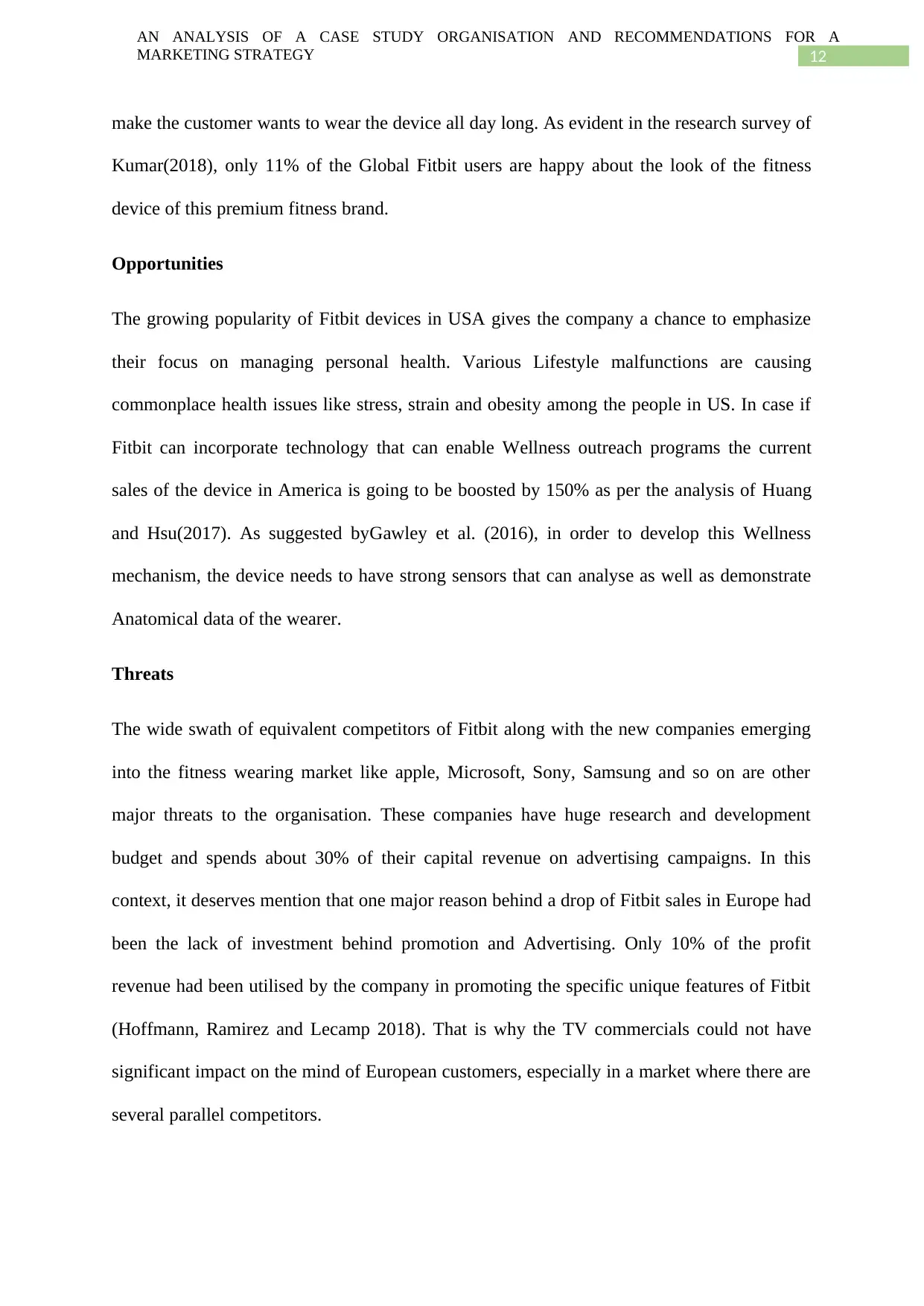
12
AN ANALYSIS OF A CASE STUDY ORGANISATION AND RECOMMENDATIONS FOR A
MARKETING STRATEGY
make the customer wants to wear the device all day long. As evident in the research survey of
Kumar(2018), only 11% of the Global Fitbit users are happy about the look of the fitness
device of this premium fitness brand.
Opportunities
The growing popularity of Fitbit devices in USA gives the company a chance to emphasize
their focus on managing personal health. Various Lifestyle malfunctions are causing
commonplace health issues like stress, strain and obesity among the people in US. In case if
Fitbit can incorporate technology that can enable Wellness outreach programs the current
sales of the device in America is going to be boosted by 150% as per the analysis of Huang
and Hsu(2017). As suggested byGawley et al. (2016), in order to develop this Wellness
mechanism, the device needs to have strong sensors that can analyse as well as demonstrate
Anatomical data of the wearer.
Threats
The wide swath of equivalent competitors of Fitbit along with the new companies emerging
into the fitness wearing market like apple, Microsoft, Sony, Samsung and so on are other
major threats to the organisation. These companies have huge research and development
budget and spends about 30% of their capital revenue on advertising campaigns. In this
context, it deserves mention that one major reason behind a drop of Fitbit sales in Europe had
been the lack of investment behind promotion and Advertising. Only 10% of the profit
revenue had been utilised by the company in promoting the specific unique features of Fitbit
(Hoffmann, Ramirez and Lecamp 2018). That is why the TV commercials could not have
significant impact on the mind of European customers, especially in a market where there are
several parallel competitors.
AN ANALYSIS OF A CASE STUDY ORGANISATION AND RECOMMENDATIONS FOR A
MARKETING STRATEGY
make the customer wants to wear the device all day long. As evident in the research survey of
Kumar(2018), only 11% of the Global Fitbit users are happy about the look of the fitness
device of this premium fitness brand.
Opportunities
The growing popularity of Fitbit devices in USA gives the company a chance to emphasize
their focus on managing personal health. Various Lifestyle malfunctions are causing
commonplace health issues like stress, strain and obesity among the people in US. In case if
Fitbit can incorporate technology that can enable Wellness outreach programs the current
sales of the device in America is going to be boosted by 150% as per the analysis of Huang
and Hsu(2017). As suggested byGawley et al. (2016), in order to develop this Wellness
mechanism, the device needs to have strong sensors that can analyse as well as demonstrate
Anatomical data of the wearer.
Threats
The wide swath of equivalent competitors of Fitbit along with the new companies emerging
into the fitness wearing market like apple, Microsoft, Sony, Samsung and so on are other
major threats to the organisation. These companies have huge research and development
budget and spends about 30% of their capital revenue on advertising campaigns. In this
context, it deserves mention that one major reason behind a drop of Fitbit sales in Europe had
been the lack of investment behind promotion and Advertising. Only 10% of the profit
revenue had been utilised by the company in promoting the specific unique features of Fitbit
(Hoffmann, Ramirez and Lecamp 2018). That is why the TV commercials could not have
significant impact on the mind of European customers, especially in a market where there are
several parallel competitors.
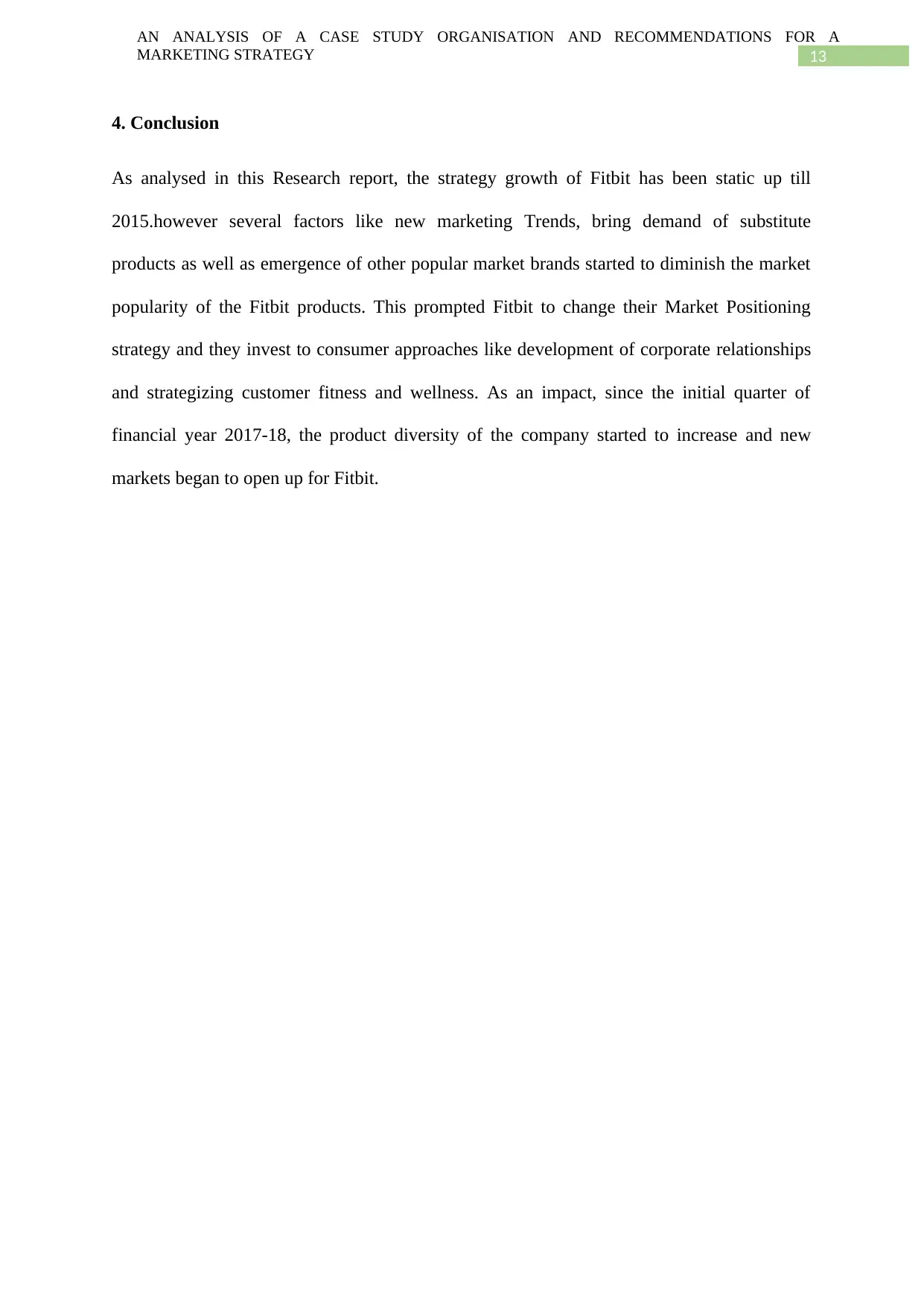
13
AN ANALYSIS OF A CASE STUDY ORGANISATION AND RECOMMENDATIONS FOR A
MARKETING STRATEGY
4. Conclusion
As analysed in this Research report, the strategy growth of Fitbit has been static up till
2015.however several factors like new marketing Trends, bring demand of substitute
products as well as emergence of other popular market brands started to diminish the market
popularity of the Fitbit products. This prompted Fitbit to change their Market Positioning
strategy and they invest to consumer approaches like development of corporate relationships
and strategizing customer fitness and wellness. As an impact, since the initial quarter of
financial year 2017-18, the product diversity of the company started to increase and new
markets began to open up for Fitbit.
AN ANALYSIS OF A CASE STUDY ORGANISATION AND RECOMMENDATIONS FOR A
MARKETING STRATEGY
4. Conclusion
As analysed in this Research report, the strategy growth of Fitbit has been static up till
2015.however several factors like new marketing Trends, bring demand of substitute
products as well as emergence of other popular market brands started to diminish the market
popularity of the Fitbit products. This prompted Fitbit to change their Market Positioning
strategy and they invest to consumer approaches like development of corporate relationships
and strategizing customer fitness and wellness. As an impact, since the initial quarter of
financial year 2017-18, the product diversity of the company started to increase and new
markets began to open up for Fitbit.
Paraphrase This Document
Need a fresh take? Get an instant paraphrase of this document with our AI Paraphraser
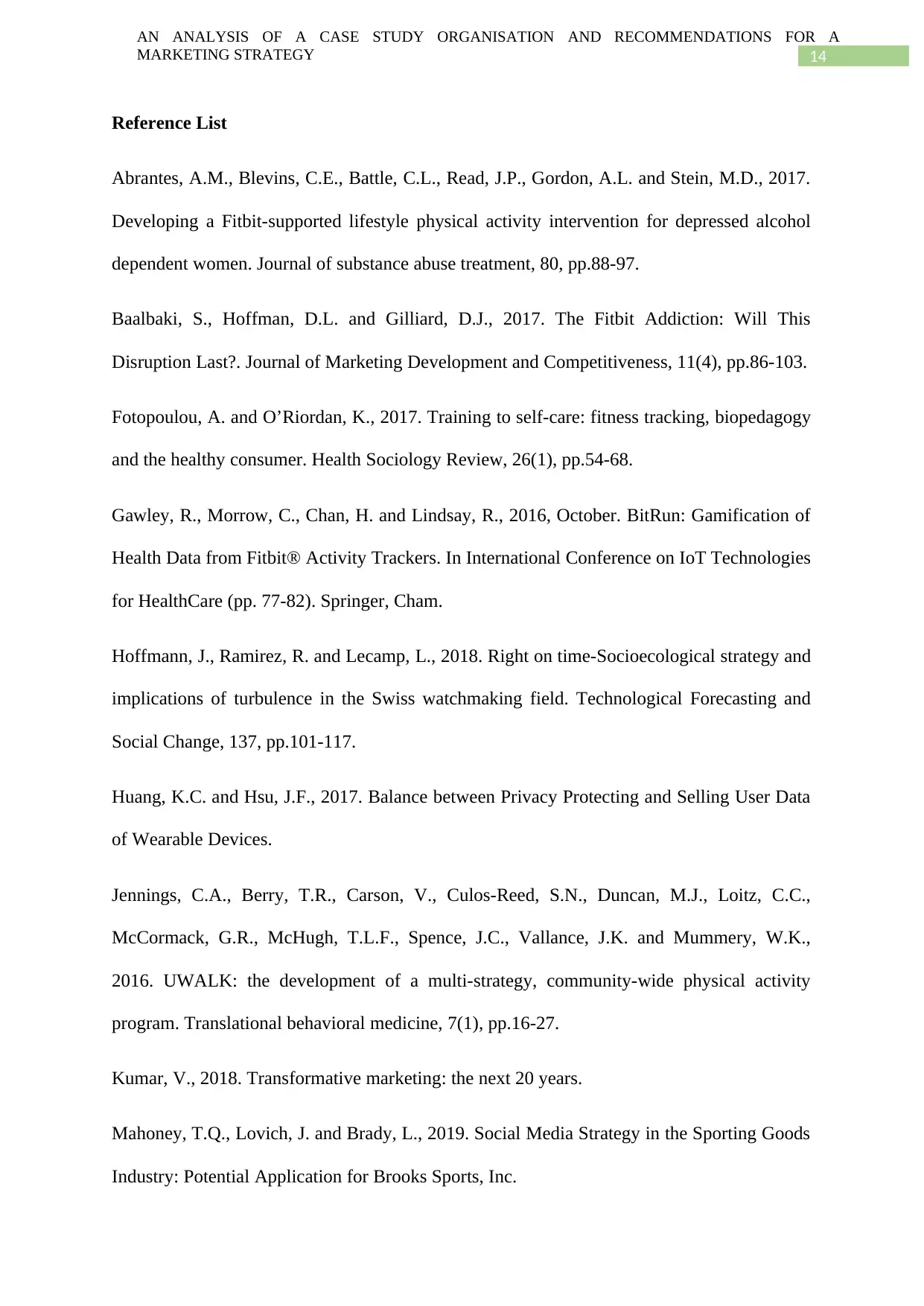
14
AN ANALYSIS OF A CASE STUDY ORGANISATION AND RECOMMENDATIONS FOR A
MARKETING STRATEGY
Reference List
Abrantes, A.M., Blevins, C.E., Battle, C.L., Read, J.P., Gordon, A.L. and Stein, M.D., 2017.
Developing a Fitbit-supported lifestyle physical activity intervention for depressed alcohol
dependent women. Journal of substance abuse treatment, 80, pp.88-97.
Baalbaki, S., Hoffman, D.L. and Gilliard, D.J., 2017. The Fitbit Addiction: Will This
Disruption Last?. Journal of Marketing Development and Competitiveness, 11(4), pp.86-103.
Fotopoulou, A. and O’Riordan, K., 2017. Training to self-care: fitness tracking, biopedagogy
and the healthy consumer. Health Sociology Review, 26(1), pp.54-68.
Gawley, R., Morrow, C., Chan, H. and Lindsay, R., 2016, October. BitRun: Gamification of
Health Data from Fitbit® Activity Trackers. In International Conference on IoT Technologies
for HealthCare (pp. 77-82). Springer, Cham.
Hoffmann, J., Ramirez, R. and Lecamp, L., 2018. Right on time-Socioecological strategy and
implications of turbulence in the Swiss watchmaking field. Technological Forecasting and
Social Change, 137, pp.101-117.
Huang, K.C. and Hsu, J.F., 2017. Balance between Privacy Protecting and Selling User Data
of Wearable Devices.
Jennings, C.A., Berry, T.R., Carson, V., Culos-Reed, S.N., Duncan, M.J., Loitz, C.C.,
McCormack, G.R., McHugh, T.L.F., Spence, J.C., Vallance, J.K. and Mummery, W.K.,
2016. UWALK: the development of a multi-strategy, community-wide physical activity
program. Translational behavioral medicine, 7(1), pp.16-27.
Kumar, V., 2018. Transformative marketing: the next 20 years.
Mahoney, T.Q., Lovich, J. and Brady, L., 2019. Social Media Strategy in the Sporting Goods
Industry: Potential Application for Brooks Sports, Inc.
AN ANALYSIS OF A CASE STUDY ORGANISATION AND RECOMMENDATIONS FOR A
MARKETING STRATEGY
Reference List
Abrantes, A.M., Blevins, C.E., Battle, C.L., Read, J.P., Gordon, A.L. and Stein, M.D., 2017.
Developing a Fitbit-supported lifestyle physical activity intervention for depressed alcohol
dependent women. Journal of substance abuse treatment, 80, pp.88-97.
Baalbaki, S., Hoffman, D.L. and Gilliard, D.J., 2017. The Fitbit Addiction: Will This
Disruption Last?. Journal of Marketing Development and Competitiveness, 11(4), pp.86-103.
Fotopoulou, A. and O’Riordan, K., 2017. Training to self-care: fitness tracking, biopedagogy
and the healthy consumer. Health Sociology Review, 26(1), pp.54-68.
Gawley, R., Morrow, C., Chan, H. and Lindsay, R., 2016, October. BitRun: Gamification of
Health Data from Fitbit® Activity Trackers. In International Conference on IoT Technologies
for HealthCare (pp. 77-82). Springer, Cham.
Hoffmann, J., Ramirez, R. and Lecamp, L., 2018. Right on time-Socioecological strategy and
implications of turbulence in the Swiss watchmaking field. Technological Forecasting and
Social Change, 137, pp.101-117.
Huang, K.C. and Hsu, J.F., 2017. Balance between Privacy Protecting and Selling User Data
of Wearable Devices.
Jennings, C.A., Berry, T.R., Carson, V., Culos-Reed, S.N., Duncan, M.J., Loitz, C.C.,
McCormack, G.R., McHugh, T.L.F., Spence, J.C., Vallance, J.K. and Mummery, W.K.,
2016. UWALK: the development of a multi-strategy, community-wide physical activity
program. Translational behavioral medicine, 7(1), pp.16-27.
Kumar, V., 2018. Transformative marketing: the next 20 years.
Mahoney, T.Q., Lovich, J. and Brady, L., 2019. Social Media Strategy in the Sporting Goods
Industry: Potential Application for Brooks Sports, Inc.
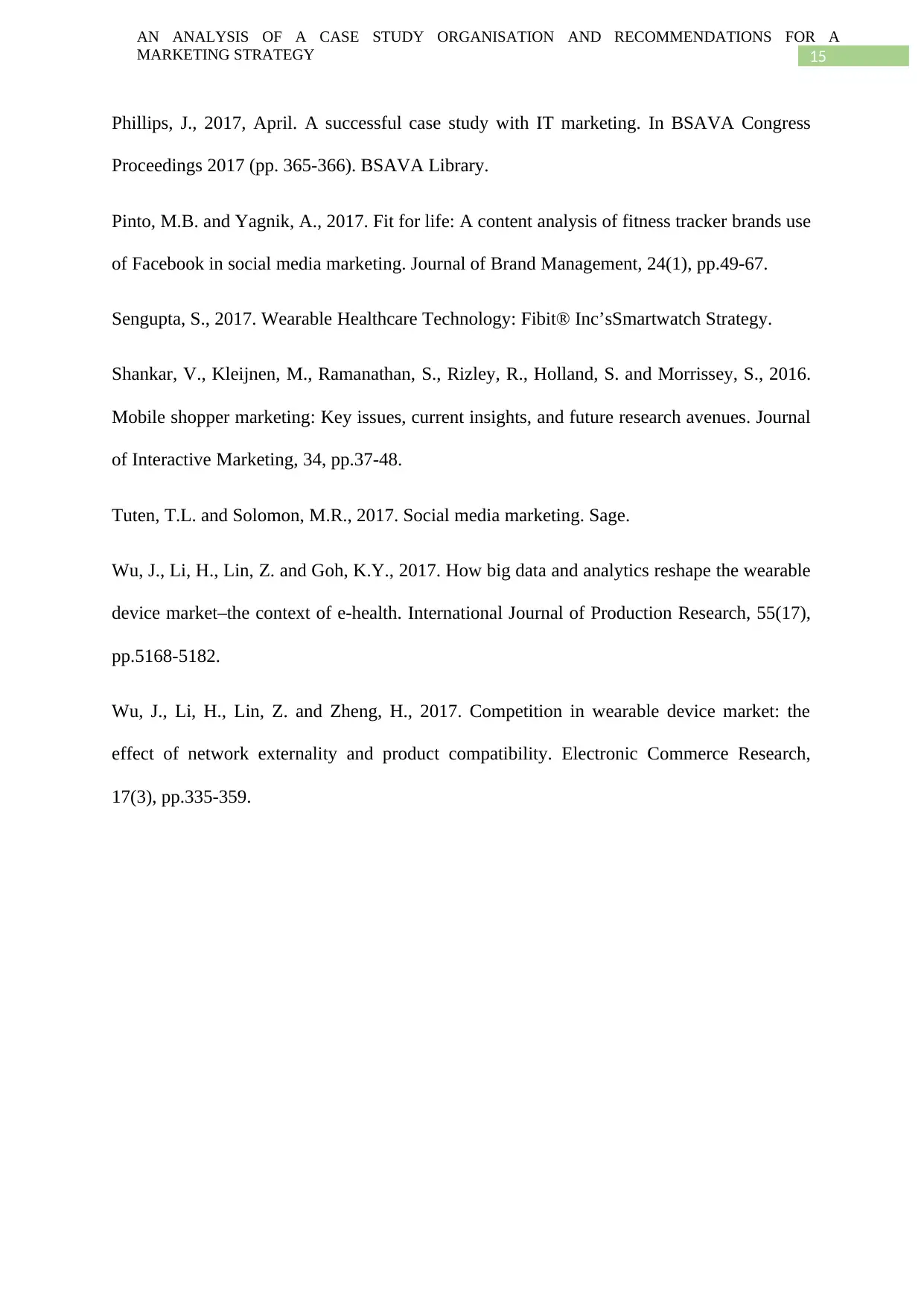
15
AN ANALYSIS OF A CASE STUDY ORGANISATION AND RECOMMENDATIONS FOR A
MARKETING STRATEGY
Phillips, J., 2017, April. A successful case study with IT marketing. In BSAVA Congress
Proceedings 2017 (pp. 365-366). BSAVA Library.
Pinto, M.B. and Yagnik, A., 2017. Fit for life: A content analysis of fitness tracker brands use
of Facebook in social media marketing. Journal of Brand Management, 24(1), pp.49-67.
Sengupta, S., 2017. Wearable Healthcare Technology: Fibit® Inc’sSmartwatch Strategy.
Shankar, V., Kleijnen, M., Ramanathan, S., Rizley, R., Holland, S. and Morrissey, S., 2016.
Mobile shopper marketing: Key issues, current insights, and future research avenues. Journal
of Interactive Marketing, 34, pp.37-48.
Tuten, T.L. and Solomon, M.R., 2017. Social media marketing. Sage.
Wu, J., Li, H., Lin, Z. and Goh, K.Y., 2017. How big data and analytics reshape the wearable
device market–the context of e-health. International Journal of Production Research, 55(17),
pp.5168-5182.
Wu, J., Li, H., Lin, Z. and Zheng, H., 2017. Competition in wearable device market: the
effect of network externality and product compatibility. Electronic Commerce Research,
17(3), pp.335-359.
AN ANALYSIS OF A CASE STUDY ORGANISATION AND RECOMMENDATIONS FOR A
MARKETING STRATEGY
Phillips, J., 2017, April. A successful case study with IT marketing. In BSAVA Congress
Proceedings 2017 (pp. 365-366). BSAVA Library.
Pinto, M.B. and Yagnik, A., 2017. Fit for life: A content analysis of fitness tracker brands use
of Facebook in social media marketing. Journal of Brand Management, 24(1), pp.49-67.
Sengupta, S., 2017. Wearable Healthcare Technology: Fibit® Inc’sSmartwatch Strategy.
Shankar, V., Kleijnen, M., Ramanathan, S., Rizley, R., Holland, S. and Morrissey, S., 2016.
Mobile shopper marketing: Key issues, current insights, and future research avenues. Journal
of Interactive Marketing, 34, pp.37-48.
Tuten, T.L. and Solomon, M.R., 2017. Social media marketing. Sage.
Wu, J., Li, H., Lin, Z. and Goh, K.Y., 2017. How big data and analytics reshape the wearable
device market–the context of e-health. International Journal of Production Research, 55(17),
pp.5168-5182.
Wu, J., Li, H., Lin, Z. and Zheng, H., 2017. Competition in wearable device market: the
effect of network externality and product compatibility. Electronic Commerce Research,
17(3), pp.335-359.
1 out of 15
Related Documents
Your All-in-One AI-Powered Toolkit for Academic Success.
+13062052269
info@desklib.com
Available 24*7 on WhatsApp / Email
![[object Object]](/_next/static/media/star-bottom.7253800d.svg)
Unlock your academic potential
© 2024 | Zucol Services PVT LTD | All rights reserved.





